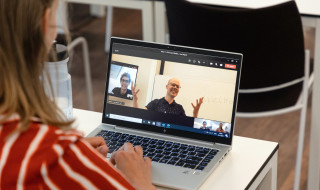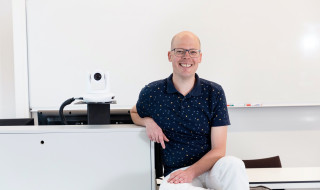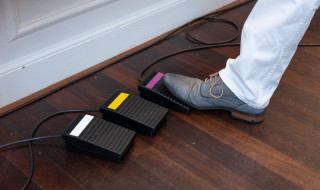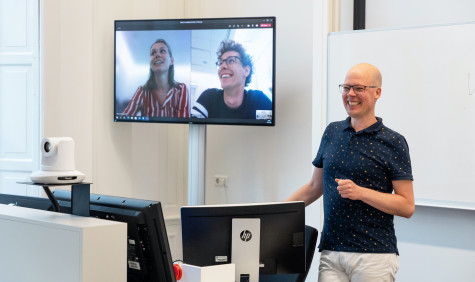"The energy level went up immediately, lessons became more dynamic"
Hybrid education with a foot pedal
"The layout of the university's teaching spaces was getting in my way more and more. My teaching style requires a lot of interaction and much less one-way traffic. I had to do something with that." Jasper van Winden, lecturer at Utrecht University, talks passionately about his initiatives to make teaching more interactive.
Adjust and motivate
It all started long before corona, with the frustration of a lecturer at Utrecht University. Jasper van Winden has been teaching the course Scientist in Advice to biology students there since 2008. During this course, they write an advisory report for a real client on topics ranging from ecology to microbiology to toxicology.
"The layout of the university's teaching spaces was getting in my way more and more," Jasper says. "Students work in groups and I like to walk into the classroom, be among the students, guide, but also participate myself. It doesn't matter so much what I write on the board or have on my sheets, I just want to know what the students are doing so I can adjust and motivate. This course and my teaching style require a lot of interaction and much less one-way traffic. So a room set up in the traditional way - with a lecturer at the front who can address the whole group - is not so suitable. I started looking into other, innovative concepts for designing teaching spaces and ended up with the 'Active Learning Classroom'."
Amidst the students
Jasper stands in an Active Learning Classrooms (ALC) with group tables for students in a circle along the walls of the classroom, each group table equipped with a whiteboard and a screen. "In the middle is the learning station, which allows me to control what is shown on the screens. That could be mine, the group's screen at the table or students' work at another table. Most striking: the room has no front. I literally move into the middle of the space between the students. This reduces the physical distance, but it also does something to the relationship between the students and me. Not only is there more interaction, communication becomes more equal."

"I set up the first classroom a bit woodsy, with a screen here and a beamer there, but following ALC's concept. You immediately noticed that the energy level went up, that the lessons became more dynamic. This set-up encourages discussions, within the group, between groups and with the lecturer. Because I can see on the screens what the students are doing, I can give feedback at the right time."
Future Learning Spaces project
Since 2016, Jasper has been involved in Educate-it, a UU-wide innovation programme that supports lecturers and students in using digital tools in teaching, in order to grow with all faculties towards a form of blended learning. His experiment with ALC led to Future Learning Spaces, a project to ensure that physical teaching spaces also support and strengthen UU's educational vision. Jasper took on the role of project manager of Future Learning Spaces.
"We started by looking closely at the core elements of UU's educational vision, such as personal, intensive, activating and small-scale. From that followed a number of didactic principles for the physical learning environment. We used these as a basis for designing new designs of teaching spaces, with which we experiment to find out whether they indeed contribute to better education. In doing so, we naturally also look at current developments in education and how technology can help us. We do this together with lecturers and students."
The first lockdown presented interesting challenges
13 March 2020 was an important day for the Future Learning Spaces project manager: the first official observation of one of the innovative facilities was to begin. But things went slightly differently. Because at the press conference the night before, Prime Minister Rutte announced the first real lockdown. He requested universities of applied sciences and universities to offer online education for the time being.

"Three things are important in hybrid education: equality, interaction and community"
"Yes, there you are with all your preparation and research. Yet this was also another very interesting challenge. Because of course, within the project we had also investigated ways of teaching at a distance. By now there was a multi-disciplinary team, with experts in didactics, but also audiovisual experts, for example. We were already working on a virtual classroom for online education and, as a multidisciplinary team, we were able to advise well on setting up a hybrid educational environment, where some of the students are on site and some remotely."
"In doing so, we were able to draw amply on the experiences lecturers and students gained in the meantime in practice. What do they stumble over, what goes well, how do lecturers want to engage remote students and how do these students want to actively participate in the lessons? But also: what do we consider important in education at Utrecht University? Out of that came three things that we find very important in hybrid education: equality, interaction and community."

"Groundbreaking was a relatively simple and almost old-fashioned-looking technical solution: a pedal on the floor. This allows me to switch between the images that the students see remotely."
Hybrid with a foot pedal
One thing quickly became clear: the success of this form of teaching hinges on the quality of the technology in the room. Image and sound have to be good, adding a single microphone in the room that properly records students' questions already makes a world of difference. But groundbreaking was a relatively simple and almost old-fashioned-looking technical solution: a pedal on the floor. With it, I can switch between the images students see from a distance: the overview image, the board, the projection screen, or me in close-up.
"That foot pedal is in front of me - more or less in the way - when I'm teaching and walking back and forth from the slides to the board. So I can hardly forget to press it to change perspective. In addition, the camera can capture the students asking questions, and there is a large screen on which the students are in view remotely. All solutions to make hybrid teaching as equal and interactive as possible. And easy to use, because it is hard enough for me and other lecturers to teach two groups at the same time. And it worked: lecturers respond enthusiastically."
Hybrid Active Learning Classroom
It was to be expected that by now the next type of teaching space would be in development: the Hybrid Active Learning Classroom, where groups consisting of on-site and remote students can work together. This includes a camera and microphone on each table. Such a teaching room is very suitable for Challenge-based learning, for example, where student teams from home and abroad work on issues and assignments from society. In the Hybrid Active Learning Classroom, the best of both concepts should come together, but whether it works in practice as conceived will be exciting. Especially whether students will not be bothered by each other's noise.
"Hybrid education offers opportunities even if there is no virus going around"
The future of hybrid education
"Due to the corona crisis, hybrid education has taken firm root in education in a short time. Whether it will last, I don't know. Fully equal education for distance and on-site students seems unfeasible to me. But hybrid education also offers opportunities, even when there is no virus going around. Like university and cross-border education, but it also makes it easier for students with disabilities to be educated. I notice that SURF is mainly a connecting factor in the search for forms of online and hybrid education. That is very valuable, because we all have our own starting points and our own vision. It's nice to have a party that knows what's going on here and there and communicates about it, so that within my institution I don't just keep thinking in our own direction."
Jasper van Winden chairs the Special Interest Group (SIG) Learning Spaces. The SIG shares expertise and knowledge on innovative Learning Spaces and also explores new areas.
